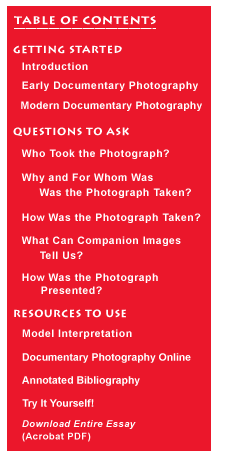talking history | syllabi | students | teachers | puzzle | about us

|
Photographs came to America in 1839 and, like many immigrants of the same era, were quickly absorbed by the nation’s growing metropolitan areas. America’s first photographic image was the silver-plated, mirror-like object called a daguerreotype, after its inventor Louis Daguerre. This new photographic process was complicated and time consuming. Preparation of a single daguerreotype plate might consume as much as thirty minutes. Exposure of the plate in the camera required subjects to remain motionless for several more minutes lest the final image be blurred beyond recognition. Because of these technological demands, early photographic pioneers rarely strayed far from their urban studios where daguerreotypes were exposed, developed, and subsequently exhibited. Because early photographs were unique images, the only way to make and distribute inexpensive copies was through print processes such as lithography and engraving, where the photographic image was drawn by an artist. The popularity of this new form of representation fostered myriad experiments, all aimed at making the entire photographic process cheaper, faster, and more portable. The introduction of ambrotypes and tintypes made possible the reproduction of paper prints from the photographic negative and thus a wider circulation of images. By the time of the Civil War, the daguerreotype and its descendents had entered the realm of middle-class consumer culture and established a popular following, often to the dismay of photographers sworn to uphold photography as an art form. Documentary photography developed during this period and was often consigned by art critics to the realm of journalism, an association that persists to the present. This consignment implied that documentary photographers were mere recorders, skilled technicians to be sure, but passive observers of the social scene and definitely not artists. Documentary photographers accepted this characterization in order to burnish the perceived realism of their imagery. They posed as fact gatherers and denied having aesthetic or political agendas. But the early practitioners of documentary photography, including acclaimed figures such as Mathew Brady, had no choice but to order the subject matter that fell within their photographic frame. Long exposure times meant that Brady and the photographers who worked for him could not capture combatants in action during the Civil War, and he had to be content with taking pictures of their bloated remains on the battlefield. In the aftermath of the 1863 battle of Gettysburg, photographer Alexander Gardner ordered that one of the fallen bodies be dragged forty yards and propped in a rocky corner. The resulting image, Rebel Sharpshooter in Devil’s Den, continues to command attention despite the recent discovery of the photographer’s manipulations.
William Henry Jackson, Mt of the Holy Cross, 1873 By the end of the Civil War, photography had already begun its unceasing march to the West, where government and corporate sponsorship helped William Henry Jackson establish himself as one of the nation’s most prolific and adventurous cameramen. Jackson crafted images of monumental proportions such as the famous photograph above of Colorado’s Mt of the Holy Cross, an image that Jackson’s friend Thomas Moran used to execute a brilliant oil painting of the same name. Moran took considerable artistic liberty with his version of this legendary landscape by bisecting the foreground with a creek that never existed. Ironically, Jackson’s original had also been altered, but out of necessity rather than aesthetic preference. Jackson had to wait until the end of the spring runoff before he could take his bulky camera equipment to a vantage point across from the mountain. To his dismay, he discovered that one arm of the fabled cross of snow had also melted. Jackson later restored that arm in his Denver darkroom. By this slight manipulation, he created one of America’s most cherished icons of western expansion. |

|
|


